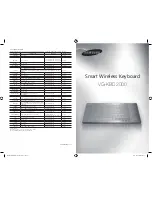
14
6.0 Direct Programming
The keyboard’s layouts and settings are stored on the v-Drive as a series of simple text files (.txt), which can
be accessed in Windows, Linux, Mac, and Chrome. Each time a remap or macro is created, it is written to the
corresponding layout .txt file as a discrete line of “code”. Each time a keyboard setting is changed, the
change is recorded in the appropriate field in the “kbd_settings.txt” file. Users can edit these files directly to
customize keyboard layouts and settings.
For those that do not have a computer that can run the SmartSet App, Direct Programming is a way to
access to the various power user tools which are not otherwise available through onboard programming.
Eject v-Drive before closing (Windows Users)
After editing any .txt files on the v-Drive, it is necessary to first save and close the files, and
then use the Windows eject protocol
before
closing the v-Drive. Right click the “FS EDGE”
removable drive in File Explorer and select Eject. Once you receive the “Safe to Eject”
notification you may proceed to closing the v-Drive with the onboard shortcut. Failure to
eject can result in a minor drive error that Windows will ask you to repair (see Section 6.7).
Non-US Users
Your computer must be configured for the English (US) keyboard layout. Other language drivers use different
codes/positions for certain keys which are critical for programming characters such as [], {} and >.
6.1 Direct Programming Layouts
The nine default layouts are saved as separate .txt files in the “layouts”
subfolder. Only custom remaps and macros are saved to the file, so if no
changes have been made to a layout, the file will be empty. Users can either
write code from scratch or edit keyboard-generated code using the syntax rules
described below. Deleting a layout file will permanently delete its stored remaps
& macros, but the keyboard will automatically regenerate a blank layout file.
File Naming Convention
Only the nine numbered layouts can be loaded to the Freestyle Edge. Additional “backup” layouts can be
saved as .txt files with descriptive names, but they cannot be loaded to the keyboard without renaming them.
Syntax Overview
Remaps and macros are encoded in a layout file using a basic programming syntax. Each of the 95 full-size
keys on the keyboard has been assigned a unique “Position” token used to identify that key during
programming (see Section 6.2). Each keyboard & mouse action supported by the Edge has been assigned a
unique “Action” token corresponding to a standard USB “scan code” (see Section 6.3). Each line of code
must include a position token and one or more action tokens. The “>“ symbol is used to separate position
tokens from actions tokens, and individual tokens are surrounded by brackets. Examples:
Remaps are encoded with Square Brackets: [position]>[action]
Macros are encoded with Curly Brackets: {position1}{position2}>{action1}{action2}{action3}...





































